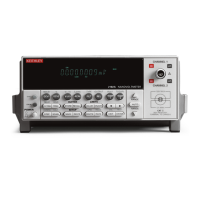Ratio and Delta 5-19
For even greater precision, the Relative feature of the Model 2182 can be used to null out
thermal EMFs, which can corrupt low voltage measurements. Use Rel as follows:
1. While displaying the Ratio result, disconnect the current source from the network.
2. Press the REL key on the Model 2182. The voltages at each input, which are thermal
EMFs, are nulled out.
3. Reconnect the current source and take the result of Ratio from the display.
When using Rel, Ratio is calculated as follows:
Filt V1-V1 Rel
Ratio =
Filt V2-V2 Rel
The above calculation includes Channel 1 Filter. If Filter is not
used, remove the “Filt” component from the calculation.
Testing superconductor materials
A superconductor sample is typically tested by either varying the current through it or varying
the magnetic field that surrounds it.
NOTE The following applications use H (magnetic field) as one of the test parameters. The
applications can easily be modified to substitute temperature (T) for H as a test
parameter.
When varying the magnetic field (H), the current (I) that flows through the DUT is fixed.
When varying the current (I) through the superconductor material (DUT), the magnetic field (H)
that surrounds it is held constant.
For the following two applications, the Model 2182 is used to measure voltage and a Keithley
SourceMeter (Model 2400, 2410, or 2420) is used to source a known current(s). Therefore,
whether varying the magnetic field or varying the current, the actual resistance of the DUT can
be calculated using Ohm’s Law: R = V/I.
Thermal EMFs — Test leads that connect the Model 2182 to the superconductor sample
(DUT) in a cryostat are typically 30 feet or longer. The test lead connections, and the wide
temperature range (from ~0K at the DUT to the ambient temperature of the lab) create
substantial thermal EMFs in the test leads. The effects of these thermal EMFs must be canceled
to achieve accurate voltage measurements.
To cancel the effects of thermal EMFs, the DC current-reversal measurement technique must
be used. This measurement technique requires a source that can provide a bipolar output. When
using a SourceMeter, a custom sweep can be configured to provide a bipolar output.
By enabling Delta measurements on the Model 2182, the effects of thermal EMFs in the test
leads will automatically be canceled during the source-measure process. For details on the DC
current-reversal technique, see “Delta.”

